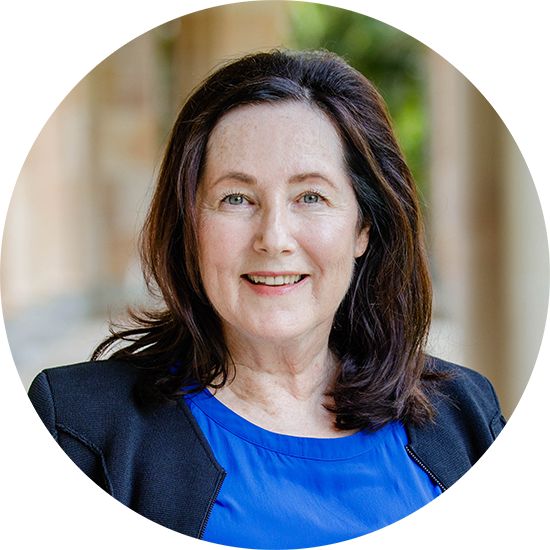Digital service transformation trends:
5 ways to stay competitive in 2024 and beyond
The digital transformation sweeping the world is revolutionising how we live and work, fuelled by new technologies such as AI, machine learning and automation.
Accounting for more than 70 per cent of GDP and 4 in 5 jobs, Australia's service sector has become a focal point in this change, spurred on by the effects of the COVID-19 pandemic.
The University of Queensland (UQ) Business School’s Service Innovation Alliance (SIA) Research Hub is at the forefront of research in this space.
Led by internationally recognised experts Professor Janet McColl-Kennedy and Associate Professor Christoph Breidbach, the SIA brought together a roundtable of 64 academic and industry representatives in November 2022, spanning finance, retail, medicine, hospitality, tourism, transportation, construction and more.
The resulting White Paper, Digital service transformation: pathways to human and economic wellbeing (PDF, 12.2 MB), addresses sector challenges and presents opportunities for business leaders to stay competitive in the digital era.
So, how can leaders refine customer experiences, create service innovations, grow their businesses and effectively manage their workforce through emerging digital technologies? Contributors to the White Paper share their strategies for 2024 and beyond.
#1 Maintaining humanness in the age
of digitalisation
SIA Research Hub Co-Lead, Professor McColl-Kennedy firmly believes that at the very core of every exciting new technology and bold digital transformation, there must beat a human heart.
Preserving a human element is a key consideration for service sector organisations, one that’s critical to human and economic wellbeing.
Professor McColl-Kennedy said clear boundaries and human oversight were crucial for the responsible implementation of new digital technology.
"We’re arguing that humans and not AI should be at the centre of business activities; that humans need to be in charge, directing and shaping the future," she said.
As AI learns from humans by observing and repeating their actions, it can be used to perform mundane and repetitive tasks, such as answering frequently asked questions or filtering email spam, and taught to undertake dangerous or dirty activities such as bomb disposal or cleaning duties.
This shift leaves service employees with a greater capacity to provide high levels of personalised customer service with empathy, intuition and detailed understanding – the human touch.
“In this sense, AI is like a personal assistant that works hard and smart,” Professor McColl-Kennedy said.
She acknowledged some concerns could arise over how much digital technology dictated a customer’s choices and experiences.
“There is a strong need to get the balance right between the machine telling the customer what to do and the customer taking some risk by experiencing the service and making choices that are important to them,” she said.
To this, Professor McColl-Kennedy said software programmers held the key.
“They write the algorithms that enable the robot, machine or AI to learn and undertake activities and make adjustments based on what works and what doesn’t,” she said.
“Clearly, human boundaries need to be established so that AI doesn’t overextend its reach.”
Professor McColl-Kennedy said both customers and businesses could maintain humanness by carefully considering a few key elements:
Establish a logical balance
AI isn’t replacing humans, but AI needs to work with humans to provide great customer experiences. That is, taking a digital-human approach.
Identify advantages for all users
Determine who benefits from AI. Is it the firm or the customer, or can it be both parties? Be specific in identifying the particular benefits for each of the respective parties.
Strengthen trust in digital
Exercise great care to determine the authenticity and integrity of digital innovations such as automation and AI. Determine on what basis decisions are being made. How much input does – or should – the customer have in decisions?
The bottom line is that businesses need insight into the decisions, predictions and outcomes made by algorithms, and customers also need some level of autonomy.
#2 Evaluating the impacts of technology on
employee wellbeing
Businesses are increasingly turning to new technology and AI to address the labour and skills shortages that emerged in the wake of the pandemic.
Co-founder of A&K Marketing and Finance Advisory Anshu Sisodia said it wasn’t just economic stability and growth guiding this approach, but also a considered effort to reduce the demands placed on employees.
Sisodia offered the example of service organisations introducing innovations such as QR code check-ins and online food delivery services.
“Allowing employees to focus on more complex and meaningful aspects of their work can lead to increased job satisfaction, engagement and reduced emotional distress,” she said.
“Additionally, businesses can use technology to provide personalised training and development plans, making employees feel valued and supported in their roles.”
With consumers increasingly demanding “the human touch” in service interactions, Sisodia said technology could enhance and automate some service elements, freeing employees up to focus on delivering personalised consumer support.
“AI can gather customer preferences and behaviour data, enabling companies to provide tailored and customised experiences,” she added.
“Most importantly, companies must invest in training employees to excel in customer service, empathy and problem-solving, as these human-centric skills are crucial in meeting customer demands for diversity, equity and inclusion.”
Sisodia offered advice for businesses to help support employee wellbeing while implementing and leveraging new technology:
Be proactive and lead by example
Creating a culture that values human and economic wellbeing is crucial for long-term success. Cultural changes often start from the top, so leaders must demonstrate their commitment towards embracing technology and supporting employees through the transition.
Encourage continuous learning and adaptation
Technology is evolving rapidly, and companies must remain agile and open to change. Businesses must communicate the purpose of new technologies clearly to employees and emphasise that AI is intended to enhance their roles, not replace them. Additionally, companies must offer training and upskilling opportunities to help employees adapt and thrive.
Remain transparent and accountable
It's critical to communicate transparently, provide training opportunities and ensure ethical AI use to not only address labour and skills shortages but also create a workplace culture that values both employees and the potential of new technology. Share success stories and case studies of how technology has positively impacted employees and customers to inspire confidence and enthusiasm for embracing new tools and processes.
#3 Embracing cybersecurity as a service
Cyberattacks are becoming increasingly sophisticated and harder to detect.
While most businesses employ capable IT experts, many are leaning on managed security service providers (MSSPs) to complement their in-house resources and offer context, advice, technology and processes to mitigate risk from cyber threats.
The White Paper explores this growing trend among businesses to build trusted partnerships with external providers to bolster cyber-resilience and accelerate digital service transformation.
Data#3 Security Sales Specialist – Managed Services Mitch Field said context was one of the greatest benefits that specialist cybersecurity service providers could offer.
“Organisations get help from MSSPs to understand what’s happening in their technology environment, what it means for them, how they should detect and respond to threats, and which risks they should prioritise and mitigate first,” Field explained.
“Those MSSPs that can provide clients with context and actionable intelligence are better placed to build trust and, ultimately, longer-term relationships.”
The UQ Bachelor of Business Management alum predicted 3 key trends would drive cybersecurity services into the future:
1. Equal opportunity
Machine learning and AI present opportunities to both cyber criminals and MSSPs. Those that can best harness these technologies will remain ahead of the game.
2. AI-powered attacks
Social engineering and phishing attacks use algorithms to generate more realistic and convincing phishing emails, text messages, chatbot interactions and voice calls. Providing regular, tailored cybersecurity awareness training presents one of the biggest opportunities for organisations to shift the dial to protect their business, staff and customer information.
3. Rapid response
Supply chains are complex and interconnected, so an exploitation that involves previously unknown vulnerabilities with no immediate patches or fixes will continue to present a risk. Organisations will need the appropriate expertise, visibility and preparedness to respond quickly.
Field said businesses and MSSPs alike should establish a clear early framework to get the most out of their service relationship:
Tailored service
Businesses should dedicate effort to their relationships with MSSPs to obtain tailored services that address their situation and problem, are ‘vendor agnostic’, and leverage existing technology where possible. Similarly, MSSPs should help businesses educate their employees and end-users to increase the overall cybersecurity culture of the organisation.
Automation and augmentation
Many MSSPs and businesses use some form of automation and machine learning on high-volume, rudimentary tasks to mitigate human error and emotive bias. What we shouldn’t try to automate are complex tasks or decisions. It’s important to use automation to complement the time and energy of a human analyst or security specialist on complex tasks and decisions.
Clear and secure communication
Create a common language to improve market awareness and understanding. Establish trusted communication platforms where stakeholders such as MSSPs, businesses or government organisations can freely share information. Attackers are much better at sharing intelligence than defenders are!
#4 Using blockchain technologies in service
Once met with confusion or scepticism, blockchain technology is now staking its claim as a key driver of digital service transformation.
Often associated with polarising applications like cryptocurrency and non-fungible tokens (NFTs), the emerging technology is rewriting its narrative as a vital business tool, said SIA Research Hub Co-Lead Associate Professor Christoph Breidbach.
Blockchain securely tracks transactions using strong cryptography without needing a central database or authority, so they become a permanent, unalterable record.
The technology presents unlimited potential for the service industry.
“Essentially, service firms can benefit from blockchain technology whenever records need to be kept and exchanged in distributed environments,” Associate Professor Breidbach said.
“Contracting, supply chain and fintech settings are among the most prominent blockchain users.”
While the technology presents significant opportunities for the service industry, the biggest may be its ability to help solve societal problems rather than business problems.
Associate Professor Breidbach used the examples of individuals bypassing banks in favour of secure peer-to-peer lending and companies applying blockchain to better understand their customers and encourage positive behavioural change, such as saving energy, conserving water or recycling.
Another major opportunity comes from blockchain’s ability to reinvent existing service systems.
“For instance, consider how blockchain could help create entirely new financial systems, such as decentralised financial institutions (DeFI), rather than adapting the technology to a current system,” Associate Professor Breidbach explained.
Continuing to reshape the narrative will unlock further potential.
“Viewing blockchain as digital infrastructure – and not just a piece of technology – helps develop industry standards and bodies, highlight individual use cases, develop ethical standards and consider the interplay of skills, context and outcomes,” Associate Professor Breidbach said.
“It also encourages and educates young people about careers in blockchain and therefore provides important societal inputs for innovation, prosperity and, ideally, wellbeing.”
Associate Professor Breidbach said a few simple steps could lower barriers to blockchain application and improve usability:
Change your mindset
In every technology-driven setting, it’s pivotal to understand, appreciate, evaluate and embrace change – it’s inevitable, and new useful technologies will eventually prevail. We can’t predict future blockchain-related developments, but we know that changing earlier is better than changing too late.
Balance exploration with exploitation
Focus on finding new ways to benefit from blockchain within specific industry contexts. Exploration can be challenging, so learn from the adoption, use and trajectories of other emerging technologies, such as HTML and peer-to-peer sharing platforms.
Embrace novelty
Innovation often emerges from those who don’t hold too tightly to established markets, organisational structures and ways of thinking. Major technological advances related to blockchain will more likely arise from the work of new market entrants than from contributions made by incumbents.
#5 Achieving sustainability through
digital service transformation
According to UQ Business School Postdoctoral Research Fellow Dr Alexandria Gain, digital technologies play a vital role in improving the wellbeing of people and the planet.
“Technologies such as telehealth and MedTech solutions can enhance the wellbeing of remote communities by providing access to improved health care,” Dr Gain said.
“Another example is the use of digital twins – virtual models of physical objects – which can help community organisations better manage their natural environment and ecosystems.”
Dr Gain said service firms could leverage AI to improve their short- and long-term sustainability performance.
“In the shorter term, AI boosts efficiency through automation, greater precision and process optimisation, which can reduce waste in supply chains,” she said.
“For example, AI-powered demand forecasting can help reduce waste from overproduction, while AI-enabled process optimisation can help firms more efficiently use resources – an effective way to reduce emissions.”
In the longer term, Dr Gain said AI had significant potential to support innovations that deliver transformative solutions, creating value for stakeholders in the service ecosystem.
“Deep learning gives firms the opportunity to develop new intelligence to solve real-world problems, such as detecting diseases and developing new products and services that meet customer needs,” she said.
Dr Gain said she had three key takeaways for service firms hoping to harness digital technology to improve sustainability:
Implement solutions at all levels
Adopting digital solutions at different levels of the service ecosystem is crucial for creating impact and change. One of the key points raised at the White Paper roundtable was, “if a solution doesn’t gain traction or become widely adopted, it isn’t a solution”.
Collaborate horizontally and vertically
To provide 'real' digital solutions that create sustainable value for all stakeholders, service firms should take horizontal and vertical approaches to collaboration. Just as diverse natural ecosystems are better equipped to thrive and adapt to disruptive events, service ecosystems and firms can benefit from the knowledge sharing and innovation that comes with collaborating with multiple stakeholders.
Expand your understanding of your stakeholders
Increasingly, service providers must deliver solutions with a deeper understanding of what their stakeholders value and the benefits they seek. These solutions could be part of integrated systems designed by technology itself.
For example, IBM uses AI to design more sustainable and resilient supply chain solutions by increasing the transparency, traceability, and orchestration of their end-to-end supply chain. These AI-powered solutions have multiple benefits, such as improving customer satisfaction by fulfilling delivery promises, guaranteeing product quality and safety, and demonstrating responsible and sustainable product sourcing. They also increase stakeholder trust, boost efficiency, reduce waste, and better predict and respond to disruptions such as extreme weather events.
Learn how business leaders can stay competitive and thrive in a technology-augmented sector by downloading the full White Paper: Digital service transformation: pathways to human and economic wellbeing (PDF, 12.2 MB).
Discover how UQ Business School’s Service Innovation Alliance is leading the way in informing the future of service organisations.
Professor Janet McColl-Kennedy

Professor Janet McColl-Kennedy is a Professor of Marketing and Co-Lead of the Service Innovation Alliance Research Hub at UQ Business School. She’s also the Lead of the Innovation Pathways Program within the Food and Beverage Accelerator (FaBA).
Associate Professor Christoph Breidbach

Associate Professor Christoph Breidbach is an Associate Professor of Business Information Systems and Co-Lead of the Service Innovation Alliance Research Hub at UQ Business School.
Dr Alexandria Gain

Dr Alexandria Gain is a Postdoctoral Research Fellow in Marketing within the UQ Food and Beverage Accelerator (FaBA) Innovation Pathways Program.
Anshu Sisodia

Anshu Sisodia is the Co-Founder of A&K Marketing and Finance Advisory, a boutique corporate advisory firm that provides clients with strategic marketing, communications, media and financial advice from industry leaders.
Mitch Field

Mitch Field is a Security Sales Specialist – Managed Services at Data#3, an award-winning Australian IT services and solutions provider. He’s also a UQ Bachelor of Business Management (2006) alum.

